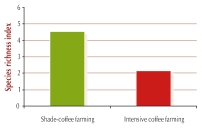
In the Dominican Republic, studies show that bird diversity is much lower in intensive full-sun coffee plantations, compared with traditional coffee plantations. These results are consistent across a wide range of other wildlife groups, from arthropods to mammals.

Traditional coffee plantations are ‘shade systems’ where the plants are grown under rainforest trees. Although disruptive to the understorey, this method allows several guilds of forest birds and other indigenous biodiversity to survive within the complex vegetation structure. In the Cordillera Central of the Dominican Republic, bird diversity is much lower in intensive full-sun coffee plantations, compared with traditional coffee plantations, shaded by native Inga trees (see figure) (Wunderle and Latta 1996). This is one of many studies to demonstrate that forest bird communities are depleted when shade-coffee systems are converted to full-sun intensive farming (Donald 2004). These results are consistent across a wide range of other wildlife groups (Wunderle and Latta 1996) from arthropods (Perfecto et al. 1996) to mammals (Gallina et al. 1996). Certain guilds of birds suffer especially badly; for example, nectar-feeding birds dependent on forest flowers are virtually eliminated from intensive coffee plantations. Conversion to full-sun systems clearly reduces the value of these agricultural habitats for forest bird communities.
References
Compiled: 2004 Copyright: 2004
Recommended Citation:
BirdLife International (2004)
Intensively farmed coffee supports many fewer bird species than traditional shade plantations.
Downloaded from https://datazone.birdlife.org/sowb/casestudy/intensively-farmed-coffee-supports-many-fewer-bird-species-than-traditional-shade-plantations on 22/12/2024